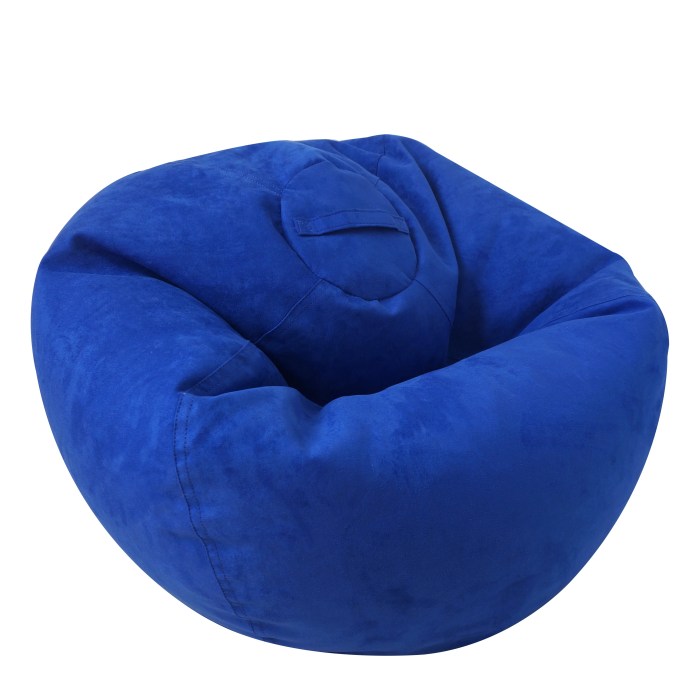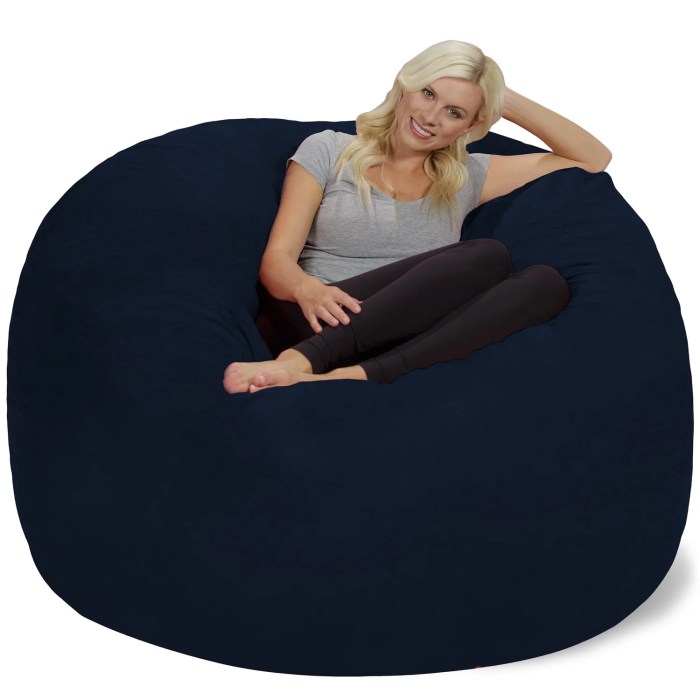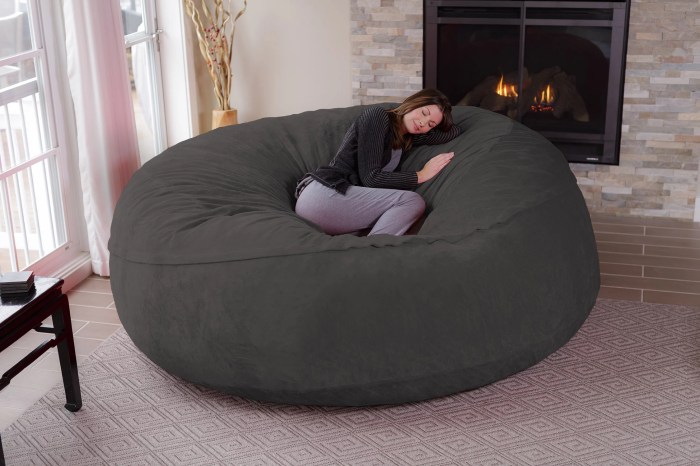Bean bags, the epitome of comfort and style, invite you to sink into a world of relaxation and unparalleled coziness. From their versatile designs to their practical applications, bean bags have become an indispensable part of modern living, offering a touch of comfort and a dash of style to any space.
With their adaptability to various settings, bean bags transcend the boundaries of indoor and outdoor spaces, bringing a touch of comfort to any occasion. Whether you’re seeking a cozy corner for reading, a stylish accent for your living room, or a comfortable companion for outdoor gatherings, bean bags effortlessly fulfill your needs.
Bean Bag Materials

Bean bags are made from a variety of materials, each with its own advantages and disadvantages. The most common materials used in bean bag construction are fabric and filling.
The fabric used for bean bags can be made from a variety of materials, including cotton, polyester, nylon, and leather. Cotton is a natural fiber that is soft and comfortable, but it is not as durable as other materials. Polyester is a synthetic fiber that is strong and durable, but it can be less breathable than cotton.
Nylon is a synthetic fiber that is strong, durable, and water-resistant, but it can be more expensive than other materials. Leather is a natural material that is durable and water-resistant, but it can be more expensive than other materials.
The filling used for bean bags can be made from a variety of materials, including polystyrene beads, shredded foam, and feathers. Polystyrene beads are small, lightweight beads that are made from expanded polystyrene. They are inexpensive and provide good support, but they can be noisy and can lose their shape over time.
Shredded foam is made from pieces of foam that have been shredded into small pieces. It is more comfortable than polystyrene beads, but it can be more expensive and can also lose its shape over time. Feathers are a natural material that is soft and comfortable, but they can be expensive and can attract dust mites.
The following table compares the pros and cons of each material:
| Material | Pros | Cons |
|---|---|---|
| Cotton | Soft and comfortable | Not as durable as other materials |
| Polyester | Strong and durable | Less breathable than cotton |
| Nylon | Strong, durable, and water-resistant | More expensive than other materials |
| Leather | Durable and water-resistant | More expensive than other materials |
| Polystyrene beads | Inexpensive and provides good support | Noisy and can lose their shape over time |
| Shredded foam | More comfortable than polystyrene beads | More expensive and can also lose its shape over time |
| Feathers | Soft and comfortable | Expensive and can attract dust mites |
Bean Bag Designs

Bean bags have evolved from simple, shapeless sacks into a diverse range of designs that cater to various aesthetic preferences and ergonomic needs.
The shape of a bean bag significantly influences its comfort and functionality. Round or teardrop-shaped designs provide a cozy and enveloping experience, conforming to the body’s curves. Square or rectangular bean bags offer more support and stability, making them ideal for reading or watching TV.
Some bean bags feature unique shapes, such as animal forms or abstract sculptures, adding a playful touch to any room.
Size is another important consideration when choosing a bean bag. Smaller bean bags are suitable for children or limited spaces, while larger bean bags provide ample room to stretch out and relax. The filling volume also affects the firmness of the bean bag, with more filling resulting in a firmer seat.
Color and fabric choice play a crucial role in the overall aesthetic of a bean bag. Vibrant colors and bold patterns can create a playful and energetic atmosphere, while neutral tones and soft fabrics evoke a sense of calm and relaxation.
While bean bags offer a comfortable and casual seating option, traditional tatami mats provide a unique blend of comfort and functionality. These mats, often found in Japanese homes, feature a woven texture that conforms to your body, providing support and relaxation.
Their natural fibers create a calming ambiance, while their versatility allows them to serve as both a seating surface and a sleeping space. However, when it comes to casual lounging and comfort, bean bags remain an unmatched choice for their adaptability and playful charm.
The fabric should be durable and easy to clean, especially if the bean bag is intended for outdoor use.
Ergonomic Considerations
Ergonomic bean bags are designed to provide optimal support and comfort for the body. They often feature lumbar support and adjustable headrests to reduce strain and promote proper posture. Memory foam or high-density polystyrene fillings conform to the body’s contours, providing a personalized seating experience.
Some bean bags also incorporate heating or cooling features for added relaxation.
Bean bags are a great way to relax and unwind, but they can also be a pain to move around. If you’re looking for a more comfortable and supportive option, consider a koala mattress . Koala mattresses are made with a unique foam that conforms to your body, providing excellent support and pressure relief.
They’re also incredibly comfortable, so you can drift off to sleep in no time. And best of all, they’re easy to move around, so you can take them with you wherever you go. Bean bags are great for lounging around, but if you’re looking for a more comfortable and supportive option, consider a koala mattress.
Comfort Levels
The comfort level of a bean bag depends on several factors, including the shape, size, filling, and fabric. Round bean bags with soft fillings offer a cozy and enveloping sensation, while square or rectangular bean bags with firmer fillings provide more support.
Larger bean bags provide ample space to stretch out and relax, while smaller bean bags are more portable and suitable for smaller spaces.
The fabric choice also affects comfort. Breathable fabrics like cotton or linen prevent overheating, while plush fabrics like velvet or faux fur provide a luxurious and inviting feel. Some bean bags feature removable covers, allowing for easy cleaning and customization.
Bean Bag Fillings
The filling of a bean bag is a crucial factor that determines its comfort, support, and durability. Various types of fillings are available, each with its own set of advantages and disadvantages.
Polystyrene Beads
Polystyrene beads, also known as Styrofoam beads, are a popular filling material for bean bags due to their low cost and lightweight nature. These beads are small, round, and made of expanded polystyrene, a type of plastic.
- Benefits:Polystyrene beads are lightweight, inexpensive, and provide good support. They are also resistant to mold and mildew, making them suitable for outdoor use.
- Drawbacks:Polystyrene beads can become compacted over time, reducing the support and comfort of the bean bag. They can also be noisy and rustle when moved.
Shredded Foam
Shredded foam, typically made from polyurethane or memory foam, is another common filling material for bean bags. This filling provides a more plush and comfortable seating experience compared to polystyrene beads.
Bean bags, known for their cozy and adaptable form, offer a delightful seating experience. If you seek enhanced comfort, consider pairing them with a mattress topper . These plush layers add an extra touch of softness, elevating the bean bag’s already indulgent embrace.
By customizing your bean bag with a mattress topper, you create a personalized haven of relaxation that caters to your specific preferences.
- Benefits:Shredded foam conforms to the body, providing excellent support and comfort. It is also durable and long-lasting.
- Drawbacks:Shredded foam is more expensive than polystyrene beads and can be heavier. It may also retain heat, making it less suitable for warm climates.
Other Fillings
Besides polystyrene beads and shredded foam, other materials can be used as bean bag fillings, including:
- Buckwheat hulls:These hulls provide excellent support and are biodegradable, making them an eco-friendly option.
- Rice:Rice is a natural and inexpensive filling material that offers good support and conforms to the body.
- Beans:Beans, such as dried soybeans or lentils, can be used as a filling, providing a firm and supportive seating experience.
Bean Bag Uses
Bean bags have gained immense popularity due to their versatility and comfort. They offer a myriad of uses, both indoors and outdoors, enhancing the ambiance and providing relaxation in various settings.
Indoor Uses:
- Living Room:Bean bags serve as cozy seating options in living rooms, adding a touch of casual elegance to the space. They are perfect for lounging, reading, or watching movies.
- Bedroom:Bean bags can create a cozy reading nook or provide extra seating in bedrooms. Their soft and comfortable nature makes them ideal for relaxing and unwinding.
- Playroom:Bean bags are a safe and fun seating option for playrooms, providing a comfortable and flexible seating arrangement for children.
Outdoor Uses:
- Patio:Bean bags are weather-resistant and can be used on patios to create a relaxing outdoor lounge area. They provide a comfortable and stylish seating option for enjoying the outdoors.
- Poolside:Bean bags are perfect for poolside lounging, offering a comfortable and portable seating solution. They are water-resistant and can withstand the elements.
- Camping:Bean bags can be used as comfortable seating options during camping trips. They are lightweight and easy to carry, making them a convenient and practical choice.
Bean bags offer endless possibilities for enhancing comfort and style in various settings. Their versatility and adaptability make them a popular choice for both indoor and outdoor use, providing a cozy and relaxing seating experience.
Bean Bag Care and Maintenance
Maintaining the cleanliness and integrity of your bean bag is crucial to ensuring its longevity and optimal comfort. Here’s a comprehensive guide to help you care for and maintain your bean bag:
Cleaning Frequency and Methods, Bean bag
- Regular vacuuming: Use a vacuum cleaner with a soft brush attachment to remove dust and debris from the bean bag’s surface.
- Spot cleaning: For spills or stains, use a damp cloth with a mild detergent to gently wipe the affected area. Avoid using harsh chemicals or bleach, as they can damage the fabric.
- Deep cleaning: For a thorough clean, follow the manufacturer’s instructions for machine washing or dry cleaning. If machine washing, use cold water and a gentle cycle, and avoid using bleach.
Special Care Considerations
- Protect from direct sunlight: Prolonged exposure to sunlight can fade the fabric and damage the filling.
- Avoid overloading: Overstuffing the bean bag can strain the seams and cause premature wear.
- Refill as needed: Over time, the filling may settle or compress, so it’s important to refill the bean bag as needed to maintain its shape and support.
Ultimate Conclusion: Bean Bag

Bean bags have revolutionized the concept of comfort, offering a unique blend of style and functionality. Their versatility, adaptability, and ease of maintenance make them a must-have for any home or outdoor space. As you explore the world of bean bags, you’ll discover a wide range of designs, fillings, and materials, empowering you to create the perfect bean bag that complements your style and needs.
So, embrace the comfort and style of bean bags and elevate your relaxation experience to new heights.
Common Queries
What are the different types of bean bag fillings?
Bean bags come with a variety of fillings, including polystyrene beads, shredded foam, and memory foam. Each filling offers unique benefits, such as durability, comfort, and support.
How often should I clean my bean bag?
Regular cleaning helps maintain the hygiene and longevity of your bean bag. Depending on usage, aim to clean the outer cover every few months and vacuum or spot-clean the filling as needed.
Can I use bean bags outdoors?
Yes, some bean bags are designed for outdoor use. Look for bean bags with water-resistant or UV-resistant materials to withstand the elements.